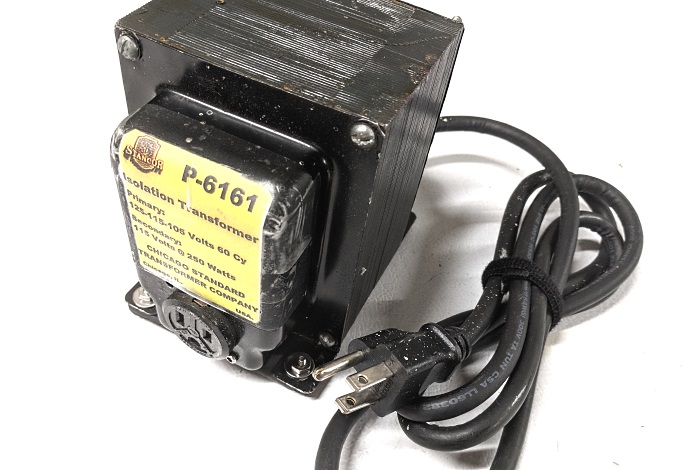Safety in a big, heavy package.
The isolation transformer is nearly as old as commerical electric power distribution. Although 1:2 (or 2:1) units are common for converting power between 105-120VAC standards and 210-240VAC standards, 1:1 units are also useful. Below is a typical unit from the early 1980s (Stancor P-6161):

Figure 1. A common type of isolation transformer from olden days.
The isolation transformer presents an impedance in the current path, which limits the available short-circuit current at the output compared to the mains. Another benefit, if so designed, is the ability to tap the winding around the nominal voltage point. The pictured unit has an input-side selector switch for 105-115-120VAC nominal against a 115VAC nominal output. While intended for compatibility with variation in the world's AC mains standards, it also permits the output voltage to be bucked (lowered) or boosted (raised) relative to input voltage, at a slight risk of overexciting the core and causing it to run hotter. (For example, it would be a bad idea to use the 105 V tap and connect to a 120 VAC mains, which would apply 14% overvoltage to the core, and run the output at about 131 VAC.)
A third, critical feature is that a transformer can provide full galvantic isolation between the earth-grounded mains and the output connection. Isolation transformer kits remain extremely common in hospital and laboratory settings for this reason, althought they now come in neat little powdercoated cabinets that hide the sharp edges and combine typical features of a powerstrip. To understand why isolation is needed, we need to review the standard connections of a mains AC service.
Modern North American construction uses three connections for a standard AC electrical outlet. People generally understand that electrical energy flows between two prongs of an outlet while the third is the the Safety Ground, but not so many understand that the Neutral conductor is also grounded, and why.
A typical residential or light-commercial service tap receives a single-phase service transformer's 240V secondary winding with a center tap that splits the winding into two 120V connections. The Neutral may be a separate bus jumpered to the ground bus, or simply integrated with the ground bus. The Safety Ground has redundant earth references, generally a pair of 10 foot (3m) copper-clad steel ground rods. If any devices with high-current motors or heating elements are present, they will often use an Active to Active (L1 to L2) connection supplying 240VAC via permanent wiring or special plug. All other circuits tap out from one Active connection and Neutral, supplying 120VAC to service outlets, small appliance loads, and lighting.

Figure 2. Typical connection of a split-phase service tap.
Now, why ground the Neutral? Wouldn't it be better to let it float, so that people would not get shocked if they accidentally create a path between Line and Ground?
Unfortunately, real-world systems are not foolproof. Nails, loose wires, rodents, equipment vibration, bad connections, and other bad conditions can chafe or melt through insulation and may create a ground reference on one conductor only. But nobody would ever know -- until the day someone accidentally made contact between the other conductor and ground, completed the circuit path, and suffered Buglight Syndrome in the bedroom due to a faulty toaster oven in the kitchen.
Hence, the Neutral is always grounded (except in a few special-purpose industrial settings). A ground-faulted connection either occurs on the Neutral which is already grounded, or it contacts L1 or L2 and creates a ground fault, tripping protective devices. Of course, modern electronics would now make ground fault detection on an ungrounded system trivially easy, but residential power has been somewhat standardized for about a century, and there are good reasons for keeping in that way.
Meanwhile for a hobbyist, there is one situation where this arrangement is undesirable: Someone is testing a device of unknown reliability, or which is suspected of having a fault. If it is defective, then that should be detected without stressing the electrical system unnecessarily or risking human harm. For this situation, we need an isolated power supply.
aaronv dot net -at- gmail dot com